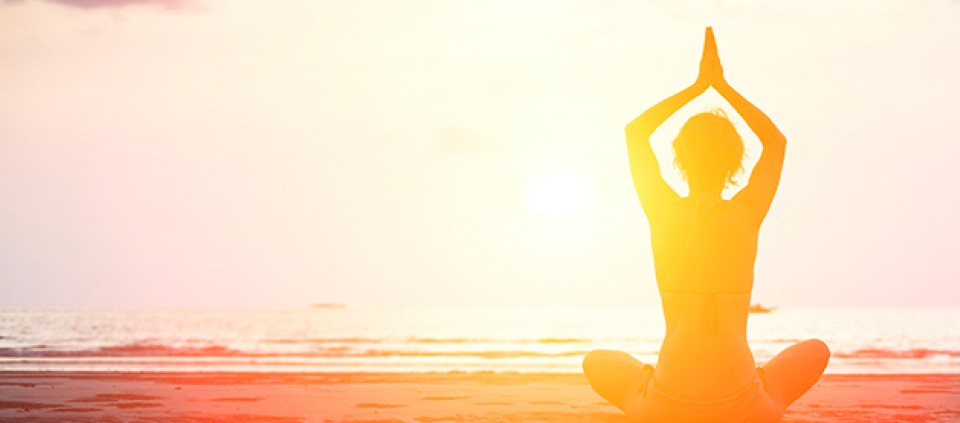10 Tips for Finding Balance in Your Yoga Practice

Does this sound familiar? The alarm clock rings, and you hit the ground running. You speed through a frenetic morning routine, and then on to your rushed commute. At work, you just make it to your first meeting, and then you skip lunch to tackle a deadline.
Finally, at the end of your workday, your multitasking mind says, If I take a vigorous, hot, power yoga class, then I’ll be getting a workout, a sauna, and deep relaxation!
Perfect solution, right? Well, that depends.
If you continue your day in fight-or-flight mode, and allow that state to push you into a fast-moving, effort-driven yoga class, you’ll continue on your overstimulated path to burnout.
I’m not here to tell you to avoid power yoga. On the contrary, I love nothing more than to dive into a sweaty, stimulating vinyasa class. But it’s essential to find healthy balance in life, and to give our bodies and minds the opportunity to manifest the relaxation response—a key to optimal health, as it can help lower the risk of heart disease, obesity, anxiety, depression, and other stress-related diseases.
Kala, Langhana, and Brahmana
The science of Ayurveda is based on the five elements: ether, air, fire, water, and earth. Certain combinations of these elements are described as doshas: Vata is air and ether, pitta is fire and water, and kapha is water and earth. Think of vata as mobile, cold, dry, light, and rough; pitta as hot, light, subtle, sharp, and oily; and kapha as slow, dense, heavy, dull, and cold. These doshas give us ways to describe any and all things, and certain doshas dominate in certain seasons: Vata rules the fall, kapha rules the spring, and pitta rules the summer. This is the concept of kala.
Choose a practice for the season that will pacify its predominating qualities instead of aggravating them. For example, in the vata season, particularly in a busy, fast-moving, city, choose a calming yoga class in a warm room. In pitta season, the height of summer, avoid a heated room or a competitive atmosphere that can enhance stress. And in kapha season, the damp, heavy springtime, choose a class that will get you moving and sweating; this is the perfect time to take that hot yoga class.
Another concept to remember is that of langhana and brahmana. Langhana translates as “that which lightens,” and brahmana as “that which builds.” Ayurveda invites us to balance by applying opposites—much like the concept of yin-yang in traditional Chinese medicine. Let this be true for how you choose your yoga class. If you’re feeling high levels of anxiety and are in need of nourishment, choose relaxation. If you’ve been sitting all day and need more mobility, go to a faster-paced class. Really listen to your body, and ask yourself, How do I feel? What do I need? We are the experts on ourselves, so we can rely on intuition to steer us in the right direction for our well-being.
10 Suggestions to Help You Find Balance in Your Yoga Practice
- If you’re a dedicated power yogi, try trading just one class per week for a restful experience. Experiment with yoga nidra, gentle yoga, Yin Yoga, restorative yoga, and meditation. You may find that you love both the permission and the opportunity to slow down and relax.
- If you tend to practice power yoga at the end of the day, try switching to the morning. In the evening, replace this activity with a 10- to 30-minute silent walk or meditation to help you wind down from the day.
- Create a space at home where you can practice yoga. A teacher’s guidance and the energy of others can be motivating; however, you can receive similar benefits (with less stimulation) in the peace and quiet of your own home.
- Practice at the same time every day. Routine creates a calming effect on the body and mind.
- Experiment with working at 65 to 75 percent of your capacity. What would it feel like to be gentler with yourself? Allow your yoga practice to be a place where you don’t have to perform at top levels.
- Focus on your breath, taking deep, slow inhales and more complete exhales. This soothes the nervous system, and allows you to systemically relax.
- Practice with your eyes closed whenever you can, and bring an eye pillow to use during Savasana. Our eyes are particularly taxed from working on computers and other screens. Pratyahara, the withdrawal of the senses, can offer healing and the freedom to go inward to feel the emotions and sensations that arise.
- Don’t leave before Savasana; stay and revel in it. Lie there and do nothing. Give your entire body a break from all that it does, and just be.
- Bring socks for Savasana. Covering the feet during relaxation can ground the vata dosha, the elements of air and ether, and calm the mind by lowering anxiety and creating safety and warmth.
- After yoga class, don’t immediately rush to check your cell phone. Let the emails, texts, and calls wait as long as possible. Even 15 minutes of cell phone–free time can be the most liberating 15 minutes of your day.
Find out about upcoming programs with Sarajean Rudman at Kripalu.
© Kripalu Center for Yoga & Health. All rights reserved. To request permission to reprint, please e-mail editor@kripalu.org.
Sarajean Rudman, E-RYT 500, is a clinical nutritionist, Kripalu Yoga teacher, Ayurvedic practitioner, life coach, fitness instructor, and outdoor adventure guide.
Full Bio and Programs